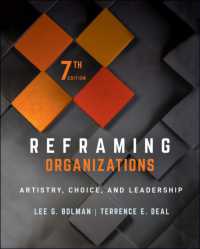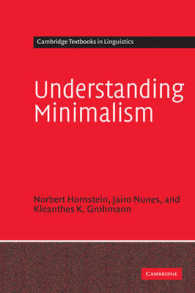- ホーム
- > 洋書
- > 英文書
- > Antiques & Collectibles
基本説明
This is the first full treatment of lacquerware made to European demand, its transportation and the lacquer market in Europe as well as the effect of lacquer and its use in a European context.
Full Description
Japanese export lacquer exerted an influence on European art and decoration quite out of proportion to its physical presence in Europe. The vast amounts shipped from Japan - mainly in three stages (1590s-1640, 1639-93, 1800-40s) - demonstrate the need for the study of this beautiful material. This is the first full treatment of lacquerware made to European demand, its transportation and the lacquer market in Europe as well as the effect of lacquer and its use in a European context. Trading patterns and uses are described in detail, based on the documentary evidence of Europeans in the Far East, notes kept by the Portuguese in Japan, the important and comprehensive archives of the Dutch East India Company (VOC), and to a lesser extent and for a shorter period, of the English Honourable East India Company, as well as on contemporary comments and inventories from Europe. Full use is also made of the sparse Japanese documentation of the trade, only available for the period 1709-11 and the early 19th century. Reference is further made to additional records kept by American ships' captains and supercargoes from Massachusetts. Additional material has been sourced from such instances as the 'embassy' to the French Court sent by the King of Siam to Paris in 1684 via the adventurer Constant Phaulkon, and lists of lacquerware and other items presented to the King of the Royal family. While the Portuguese seem to have regarded Japanese lacquer as mainly suitable for use as grand gifts, particularly within the Habsburg family network, it is surprising how much of the lacquer for the Portuguese market (the so-called Namban lacquer) survives in Europe, testifying to extensive (undocumented) private trade, as well as the orders of the Society of Jesus. The Dutch used lacquer as gifts and for trade. The English Company never traded in lacquer, but was involved in many private transactions. The inter-Asian markets were vital to the Dutch, particularly where lacquer was regarded as suitable for gifts to Oriental potentates. This is well documented, and descriptions of orders for lacquer elephant howdahs and carrying chairs gives us an insight into what has been lost. The authors describe and illustrate the huge variety of known lacquer shapes and decorations produced for all markets within the three periods mentioned above and to a lesser extent in the 18th century, where the documentation is scarce and the demand was less. This involves several hundred individual pieces, most of which are illustrated. Japanese lacquer was soon recognized as the best available and it seems never to have gone out of fashion in Europe, even when the shapes of the furniture on which it appeared did. Japanese lacquer furniture was dismantled to provide panels for inlay into European furniture as tastes changed. This important feature in the history of European furniture is discussed at length and illustrated by many examples.
Contents
Preface and Acknowledgments; Introduction; Part 1 - The Trade in Lacquer: The Portuguese in Japan; The English in Japan; The Dutch in Japan; Private Trade by Dutch Merchants in Japan. Part 2 - The Objects: Materials and Styles, Chronology and Qualities; Shapes; Part 3 - Evidence of Trade: Portugal; England; Holland and Batavia; Siam; India and Ceylon; Taiwan and elsewhere; France; Japan; Part 4 - Evidence of Reception in Europe: Portugal and Spain; Italy, France, Germany and Scandinavia; England and Holland; Appendices: Portuguese Figures on Japanese Lacquer; Lacquer Gifts from the Siamese Embassy to France, 1684; Price Range of Dutch Market Lacquer; Cross Reference List; Bibliography; Glossary; Index








